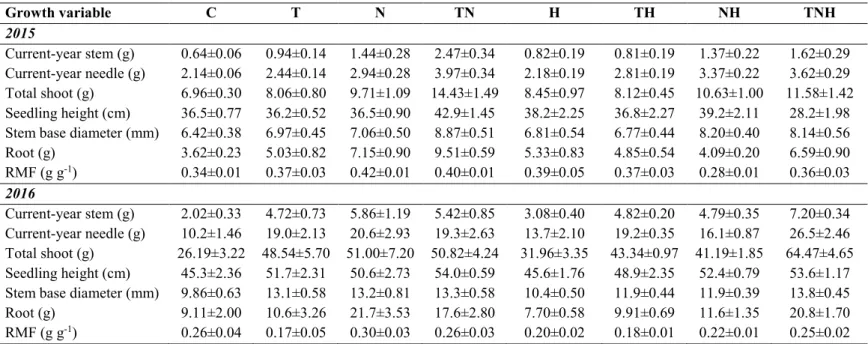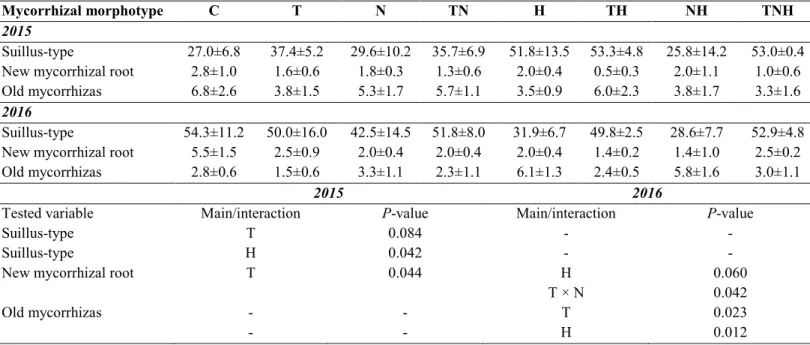According to the latest IPCC report (Allen et al. 2018), anthropogenic activities have already caused a 36. Large pine weevils feed on the bark of young coniferous plants as well as the crowns of the mature trees, including 52. Scots pine is a dominant coniferous tree species in the Finnish forests ( Parviainen et al. 2010, Aarne 2013), and expected 58.
Based on previous multifactorial studies with low to moderate herbivory (Rasheed et al. 2017, Tiiva et al. 2018), we hypothesized that 4) the biotic and abiotic factors will exhibit interactive effects; In each exposure season, half of the elevated temperature plots and half of the ambient temperature plots were 170. The bite marks were marked with a permanent marker and photographs of the stems were taken from 204.
Feed damage intensity was calculated as the percentage of the total bark area of the main shoot in 2015 209. At the end of each growing season, the diameter of the stem base and the height of the seedling (from the base of the main shoot to the tip of the 224 apical bud) of all seedlings were measured.
13 after this data reduction, 20 classes of the finer root fractions (Ø ≤ 2.0 mm) with 0.1 mm interval were maintained.
In 2015 and 2016, soil samples for nutrient and pH analysis were collected from each experimental plot at 308. Soil C and N analyzes were performed with a CHN analyzer (Elementar Vario MAX CHN, Elementar 309 . Analysensysteme GmbH, Germany), while when the total concentrations of P, K, Ca and Mg are measured inductively 310. Since we used destructive harvesting of seedlings in every year, we did not have herbivorous treatment in 2014, and 317.
RMF, root morphology and microscopy data, root ergosterol and phenolics, soil PLFAs and needle C and N 324. ANOVA tests, the data were tested for normality and outliers were omitted when necessary (outliers were tested 328 .. The root fraction and phenolics data were log-transformed by SIMCA-P version 14; Umetrics, Umeå, Sweden).
16 3 Results
Based on the SME tests, heating increased all of the above dry masses and stem diameter more without 379.
Root ergosterol levels were increased by 45% as a result of N addition in herbivorous seedlings (N+ versus N- in H+, Fig. 4). T main effect) tended to increase and herbivory (H main effect) increased the colonization rate of Suillus type 448. The number of new short mycorrhizal roots also decreased due to N addition at ambient temperature 453.
H interaction) increased the proportion of gram-positive bacteria (Figure 6a) and decreased the proportion of gram-negative 456.
21 4 Discussion
22 Warming and N addition in combination increased root dry masses in both years, though in 2016 this trend was
22 Warming and N addition in combination increased root dry matter in both years, although this trend was in 2016. It has been suggested that herbivores from shoots may be detrimental to root growth, mainly due to interrupted C supply 515. Increases in RRI and SRL may reflect an increase in the efficiency of soil testing of the fine root system (Ostonen et 533 .
24 increased efficiency of soil search stress was achieved either through increased branching of fine roots (2015) or through.
24 stress increased soil exploration efficiency was gained either via increased fine root ramification (2015) or via
Conclusions 581
26 6. Acknowledgements
27 7. Appendix
28 Summary of all possible main and interaction effects and simple main effects (SME) comparison explanation
29 8. References
30 Cudlin P, Kieliszewska-Rokicka B, Rudawska M, Grebenc T, Alberton O, Lehto T, Bakker MR, Börja I, Konopka Cudlin P, Kieliszewska-Rokicka B, Rudawska M, Grebenc T, Alberton O, Lehto T, Bakker MR. , Börja I, Konopka 641. Fine roots and ectomycorrhizae as indicators of environmental 642. and wood-boring insects in living trees in Europe, a synthesis, ed. Combined effects of elevated ozone, temperature, and nitrogen on 667 Scots pine effluent phenolic concentrations.
31 Gref R, Ericsson A (1985) Wound-induced changes in resin acid concentration in living bark of Scots pine.
32 Kuikka K, Härmä E, Markkola A, Rautio P, Roitto M, Saikkonen K, Ahonen-Jonnarth U, Finlay R, Tuomi J Kuikka K, Härmä E, Markkola A, Rautio P, Roitto M, Saikkonen K, Ahonen-Jonnarth U, Finlay R, Tuomi J 701.
33 Morreira X, Zas R, Sampedro L (2012) Quantitative comparison of chemical, biological and mechanical induction
Randriamanana TR, Nybakken L, Lavola A, Aphalo PJ, Nissinen K, Julkunen-Tiitto R (2014) Sex related 760. differences in growth and carbon allocation to defense in Populus tremulaos explained by current plant defenses 761. Reich PB, Oleksyn J (2008) Climate warming will reduce Scots pine growth and survival, except in the distant 769.
35 Selander J, Immonen A (1991) Lannoituksen vaikutus männtyntaimen tuhonalttiuteen tukkimiehentäille (Effects
36 Wallertz K, Nordenhem H, Norlander G (2014) Damage by the pine weevil Hylobius abietis to seedlings of two
Web References 834
Treatment effects on above- and below-ground growth variables (mean ± SE, n = 4 for each treatment) in Scots pine at the end of the 2015 and 2016 exposure seasons. Temperature, N addition, and herbivory treatment effects on colonization rates of Suillus-type mycorrhizae, young mycorrhizal roots, and old mycorrhizae (mean ± SE, 848. n = 4 for each treatment) in Scots pine seedlings at the end of the 2015 season and exposure 201 .

41 Figure legends
42 Fig 1 a-d
43 Fig 2 a-i
44 Fig 3 a-d
45 Fig 4 a-b
46 Fig 5 a-b
47 Fig 6 a-b
48 Online Resources
Means ± standard errors for air temperature (°C), soil temperature (°C), relative humidity (%) and soil humidity (vol%) and monthly and total online resource 2. Means ± standard errors for air temperature ( °C ), soil temperature (°C), relative air humidity (%) and soil moisture (vol %), and monthly and annual rainfall (mm).
50 Online Resource 3. Proportions of fine and coarse root fractions, mycorrhizal colonization levels and proportions
Concentrations of calcium (Ca), potassium (K), magnesium (Mg), phosphorus (P), carbon (C), nitrogen (N), carbon-nitrogen ratio (C:N), and pH values (means ± SEs) in soil from test plots in C, T, N, and TN treatments after 2015 and 2016 growing seasons. Treatment abbreviations: C = control (ambient temperature without N addition), T = temperature rise only, N = N addition only, and TN = temperature increase and N addition in combination. 54 Online source 7. Herbivore damage from bark, a) damaged shoot surface in 2016, b) damage intensity (%) Online source 7. Herbivore damage from bark, a) damaged shoot surface in 2016, b) damage intensity (%) from growing season 2016 for N addition of main effects.
Concentration of carbon (C), nitrogen (N) and carbon-to-nitrogen ratio (C:N) (mean±SEs) from current year needles in C, T, N and TN treatments in H- and H+ seedlings after growing seasons 2015 and 2016. Treatment abbreviations: H- = non-herbivore, H+ = herbivore, C = control (ambient temperature without N addition), T = temperature increase alone, N = N addition alone, and TN = temperature increase and N addition in combination . Current year stem and needle dry mass, seedling height and stem base diameter (mean ± SE) Online resource 9.
Current year stem and needle dry mass, seedling height and stem base diameter (mean ± SEs) of pine seedlings grown under C, T, N and TN treatments after 2014 growing season. LMM ANOVA results for current year stem and needle dry mass, total seedling dry mass Online resource 10. LMM ANOVA results for current year stem and needle dry mass, total seedling dry mass seedling height, stem base diameter, root dry mass and root mass fraction ( RMF) from growing seasons 2015 and 2016.
